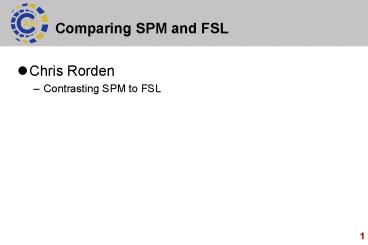Comparing SPM and FSL - PowerPoint PPT Presentation
1 / 13
Title:
Comparing SPM and FSL
Description:
Typical fMRI processing pipeline is similar. ... FSL uses FLIRT (FMRIB's Linear Image Registration Tool) to normalize. Only linear normalization. ... – PowerPoint PPT presentation
Number of Views:440
Avg rating:3.0/5.0
Title: Comparing SPM and FSL
1
Comparing SPM and FSL
- Chris Rorden
- Contrasting SPM to FSL
2
FSL vs SPM5
- We have focused on FSL
- Completely free
- Allows students to get a feel for fMRI analysis
- SPM is the most popular tool
- Free, but requires Matlab to run
- Here we contrast these tools
3
FSL3.3 vs SPM5
SPM5
FSL
- Typical fMRI processing pipeline is similar.
- In FSL, normalization is done after initial
statistics. - Allows you to see activation on original raw
scans. - Faster, as we usually super sample images during
normalization (i.e. increase field of view and
resolution).
- Motion Correction
Motion Correction
Slice Timing Correction
Slice Timing Correction
Normalization
Smoothing
Smoothing
Individual Statistics
Individual Statistics
Normalization
Group Statistics
Group Statistics
4
Motion Correction (realignment in SPM)
- Both SPM and FSL use rigid body registration.
Different cost functions are used (SPM variance
FSL Normalised Correlation). - By default, SPM aligns all images to first 4D
volume, while FSL aligns to the middle 4D volume.
- Optionally, SPM can realign and unwarp which
attempts to correct head motion related changes
in image intensity (see spatial processing
lecture). - FSLs optional solution is to add motion
parameters to statistical model (the Stats tab of
FEAT). - SPMs solution more sophisticated, but time
consuming. - Both techniques can reduce noise, but will reduce
power if head motion correlates with task (e.g.
head moves with button presses).
5
Slice Timing Correction
- Slice Timing Correction attempts to make all
slices in a 3D volume appear as if they were
collected simultaneously (see temporal processing
lecture). - Dilemma required but inaccurate for long TR,
accurate but not influential with short TR. - SPM and FSL use the same algorithm. By
convention, most SPM users employ STC for event
related designs, while FSL users do not. - We are fortunate to have a scanner that can
provide full brain coverage with a short TR.
Therefore, I would use a rapid (2sec) TR for
event related designs and not use STC.
6
Smoothing
- During the smoothing stage, both FSL and SPM
apply a spatial smoothing. - FSL also applies a 100s highpass temporal filter
to remove low frequency artefacts. - SPMs temporal filtering occurs during the
individual statistics stage, with a default 128s
highpass. - For both tools, a low pass filter is optional,
and can help block designs.
7
Normalization
- Normalization aligns the individuals brain to
stereotaxic space (warping the orientation and
size), allowing comparison between people. - SPM and FSL have very different approaches to
normalization. - In general, FSL is very robust (always
approximately right), but pretty constrained
(there tends to be a lot of residual error). - SPM is very aggressive, and can do better than
FSL in ideal circumstances (i.e. good data).
8
Normalization
- Two competing approaches for normalization (found
both in SPM and FSL) - Direct normalization
- Normalize T2 fMRI data directly to stereotaxic
space - Indirect normalization
- Coregister T2 fMRI data to T1 scan
- Normalize high resolution T1 to stereotaxic space
- Use parameters from step 2 to normalize fMRI data
to stereotaxic space - The second approach is better in theory. However,
it does require a good structural scan, and has
more chances to fail catastrophically.
9
Normalization
- FSL uses FLIRT (FMRIB's Linear Image Registration
Tool) to normalize - Only linear normalization.
- By default, direct normalization uses a T1
template image, so a between-modality
(correlation ratio) cost function is used. - FSLs analysis of DTI data uses a non-linear
registration tool (IRTK), but this is not
typically employed for fMRI data. - SPMs normalization initially uses linear
transforms, and then applies non-linear
transforms. - By default, direct normalization uses a T2
template, so a variance cost function can be
applied.
10
Normalization
- SPM5 introduces a very aggressive indirect
normalization. - The T1 scan is bias corrected and segmented to
gray matter, white matter and CSF probability
maps (see VBM lecture). - Warping these tissue maps to standard space can
provide more accurate normalization (as non-brain
tissue does not influence parameters). - FSL does skull strip data for normalization,
but this is more constrained than SPMs method.
11
Individual Statistics
- SPM and FSL apply general linear model to data
- SPM models HRF using double gamma function
(blue) by default, FSL uses a single gamma
function (red). - Both include temporal derivatives(turn these off
for block designs)
SPM and FSL have different approaches for
autocorrelation see the temporal processing
lecture.
12
Group statistics
- FSL uses estimates of each individuals contrast
parameter estimates (copes) and variability
(varcopes), SPM only uses estimates of contrast.
(see statistics lecture). - In theory, FSL might be a bit more sensitive. In
practice, it is much slower.
Z stats
Group
copes varcopes
copes varcopes
copes varcopes
copes varcopes
Sub 4
Sub 1
Sub 2
Sub 3
13
Learning SPM
- SPM5 comes with an excellent manual
- Chapter 25 walks you through analysis of a block
design. - Chapter 26 guides you through the analysis of an
event-related design.































